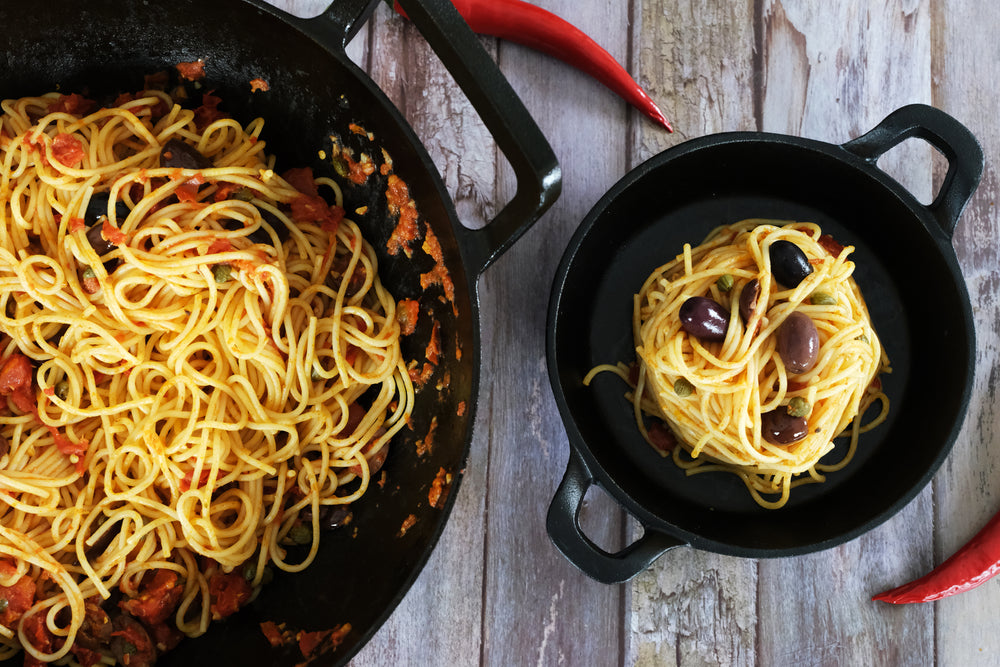En guide til matoljer: typer, røykpunkter, helsemessige fordeler og mer

Matolje er en essensiell ingrediens i mange kjøkken rundt om i verden. Den tilfører smak og tekstur til retter, samt hjelper til med matlaging og steking. Med så mange forskjellige typer matoljer tilgjengelig på markedet kan det imidlertid være forvirrende å vite hvilken olje man skal bruke til hvilken oppskrift. I dette blogginnlegget vil vi diskutere de ulike typene matoljer, deres røykepunkter, helsemessige fordeler, og hvilke oljer som ikke er sunne. Vi vil også ta en kort titt på historien til matolje.
Historien om matolje
Bruken av matoljer går tusenvis av år tilbake. De gamle grekerne og romerne brukte olivenolje til matlaging, mens kinesere og indere brukte sesam- og sennepsoljer. På 1700- og 1800-tallet var animalsk fett som svinefett og talg vanlig brukt til matlaging.
På 1900-tallet ble vegetabilske oljer som soyabønne-, raps- og solsikkeoljer populære på grunn av lav pris og tilgjengelighet. Bekymringer om helseeffektene av mettet fett og transfett førte imidlertid til en overgang til sunnere oljer som olivenolje og avokadoolje.

Typer matoljer
-
Olivenolje - Olivenolje er en populær matolje, spesielt i middelhavskjøkkenet. Den er rik på enumettede fettsyrer, som anses som bra for hjertet. Extra virgin olivenolje er den mest smakfulle og sunne typen olivenolje. Den er best egnet til å dryppe over salater, pastaretter og grønnsaker.
-
Rapsolje - Rapsolje er en nøytral olje laget av rapsplanten. Den er rik på enumettede og flerumettede fettsyrer og har et høyt røykpunkt, noe som gjør den egnet til matlaging ved høy varme, som steking og baking.
-
Kokosolje - Kokosolje er en tropisk olje laget av kjøttet fra modne kokosnøtter. Den er rik på mettet fett, noe som gjør den fast ved romtemperatur. Kokosolje har en distinkt smak og aroma og egner seg best til baking, steking og sautering.
-
Avokadoolje - Avokadoolje er rik på enumettede fettsyrer og har et høyt røykpunkt, noe som gjør den ideell for matlaging ved høy varme. Den har en mild, nøtteaktig smak og egner seg best til grilling, steking og sautering.
-
Solsikkeolje - Solsikkeolje er en nøytral olje laget av solsikkefrø. Den er rik på flerumettede fettsyrer og har et høyt røykpunkt, noe som gjør den egnet til steking og baking.
Røykpunkter
Røykpunktet til en olje er temperaturen hvor den begynner å ryke og brytes ned, og frigjør skadelige forbindelser samt gir en ubehagelig smak og lukt. Det er viktig å velge riktig olje for tilberedningsmetoden for å unngå røyking og at oljen brenner seg.
| Oljetype | Røykpunkt (°F) |
|---|---|
| Olivenolje | 375-420 |
| Rapsolje | 400-450 |
| Kokosolje | 350-375 |
| Avokadoolje | 520-570 |
| Solsikkeolje | 440-450 |
Helsefordeler
Matoljer kan gi mange helsefordeler når de brukes med måte og som en del av et sunt kosthold. Helsefordelene til hver olje varierer avhengig av fettkomposisjon og næringsinnhold.
Olivenolje er rik på enumettede fettsyrer, som har vært knyttet til å redusere risikoen for hjertesykdom, senke kolesterolnivået og forbedre insulinfølsomheten.
Rapsolje er en god kilde til omega-3 og omega-6 fettsyrer, som er essensielle for hjernehelse og å redusere betennelse i kroppen.
Kokosolje inneholder laurinsyre, som har vist seg å forbedre kolesterolnivået og øke hjernefunksjonen. Den er imidlertid også rik på mettet fett, som kan øke risikoen for hjertesykdom ved overdrevent inntak.
Avokadoolje er rik på enumettede fettsyrer og vitamin E, som har vært knyttet til å redusere betennelse, forbedre hjertehelsen og forebygge kreft.
Solsikkeolje er rik på flerumettede fettsyrer, som kan bidra til å senke kolesterolnivået og redusere betennelse i kroppen.

Usunne oljer
Noen matoljer er ikke sunne og bør unngås eller konsumeres med måte. Disse oljene er rike på mettet fett og transfett, som kan øke risikoen for hjertesykdom og andre helseproblemer.
Palmeolje er rik på mettet fett og har vært knyttet til avskoging og miljøproblemer på grunn av produksjonen. Den finnes ofte i bearbeidede matvarer og bør konsumeres med måte.
Soyabønneolje er rik på flerumettede fettsyrer, men inneholder også omega-6 fettsyrer, som kan forårsake betennelse i kroppen ved overforbruk. Den brukes ofte i bearbeidede matvarer og bør konsumeres med måte.
Maisolje er rik på flerumettede fettsyrer, men inneholder også omega-6 fettsyrer. Den brukes ofte i bearbeidede matvarer og bør konsumeres med måte.
Hvilken olje man bør bruke til salat
Når det gjelder bruk av olje som salatdressing eller til andre kalde bruksområder, blir smaken en viktigere faktor enn røykpunktet. Her er noen oljer som er flotte til salatdressinger:
-
Ekstra jomfru olivenolje - Dette er en av de mest populære oljene til salatdressinger på grunn av sin fruktige smak og helsefordeler. Den er best egnet til å dryppe over salater, pastaretter og grønnsaker.
-
Avokadoolje - Denne oljen har en mild, nøtteaktig smak og høyt røykpunkt, noe som gjør den ideell for grilling, steking og sautering. Den er også flott til salatdressinger.
-
Valnøttolje - Denne oljen har en rik, nøtteaktig smak som fungerer godt i salatdressinger. Den er rik på omega-3 fettsyrer og antioksidanter.
-
Linfrøolje - Denne oljen er rik på omega-3 fettsyrer og har en nøtteaktig smak. Den bør brukes i små mengder i salatdressinger, da den har lavt røykpunkt og kan bli bitter ved oppvarming.
-
Sesamolje - Denne oljen har en distinkt nøtteaktig smak og brukes ofte i asiatisk matlaging. Den bør brukes i små mengder i salatdressinger, da den har lavt røykpunkt og kan bli overveldende i store mengder.
Når du lager en salatdressing, er det viktig å balansere oljen med syre (som eddik eller sitronsaft) og andre krydder (som salt og pepper) for å skape en harmonisk smak. Å bruke en olje av høy kvalitet vil bidra til å løfte smaken på salaten din og gjøre den mer nytbar.
Når det gjelder salater, foretrekker noen å bruke lettere oljer som druekjerneolje, rapsolje eller solsikkeolje. Disse oljene har en nøytral smak og vil ikke overdøve de andre ingrediensene i salaten. De er imidlertid ikke like næringstette som noen av de andre oljene nevnt ovenfor.
Til syvende og sist vil den beste oljen til salatdressingen avhenge av dine personlige preferanser og smakprofilen du ønsker å oppnå. Eksperimenter med forskjellige oljer og finn de som passer best for deg. En god salatdressing kan forvandle en enkel salat til et deilig og tilfredsstillende måltid.

Avslutningsvis er det viktig å velge riktig matolje for både smak og helse. Det er viktig å vurdere røykpunkt, fettkomposisjon og næringsinnhold i hver olje når du velger hvilken olje du skal bruke til hver oppskrift. Å bruke en variasjon av sunne oljer med måte kan gi mange helsefordeler og forbedre smaken på rettene dine.
















Legg igjen en kommentar